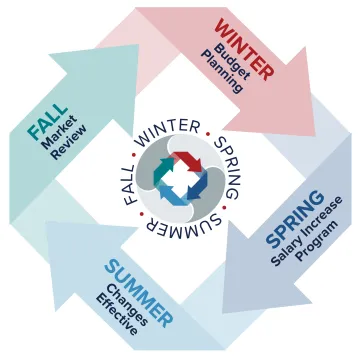
Compensation includes the combined value of an employee’s salary, benefits, retirement contributions, qualified tuition reduction and more.
This page outlines how the University of Arizona ensures our compensation structure is data-driven, equitable and in compliance with all relevant laws.
Learn the value of your total compensation package
Compensation News and Updates
The Basics
The university’s compensation philosophy is built on the following:
- Maintaining a data-driven, competitive compensation structure that is updated regularly.
- Establishing a consistent and equitable approach to pay practices.
- Complying with all relevant federal and state laws.
Fair Labor Standards Act
The FLSA is a federal law that sets labor standards. Based on FLSA standards, employees are either salaried (exempt) or hourly (overtime eligible) as determined by their compensation and job duties.
University Minimum Wage
For employees
$16.50
For student workers
$15.15
Compensation Annual Cycle
Frequently Asked Questions
As part of UCAP, the university mapped all Classified Staff employees to jobs within the career architecture. At that time, Classified Staff employees had the option to move to the University Staff position where they had been mapped or to maintain their Classified Staff status.
Employees who remain in the Classified Staff employee category still follow the FLSA exemption status and pay range of their career-architecture-mapped position. Classified Staff employees who receive a promotion or change jobs are required to transition to University Staff employment.
Yes, Classified Staff employees have the option to transition to University Staff employment at any time. They must complete the Transition to University Staff Form (PDF) and follow the submission instructions on the form.
Yes. A Classified Staff employee who meets all eligibility criteria is eligible for compensation/merit increases based on the pay grade for their mapped position.

